Attached files
| file | filename |
|---|---|
| 8-K - 8-K - CAPRICOR THERAPEUTICS, INC. | v468540_8k.htm |
Exhibit 99.1

NASDAQ: CAPR June 2017 a translational m edicine c ompany

2 Statements in this presentation regarding the efficacy, safety, and intended utilization of Capricor's product candidates ; the initiation, conduct, size, timing and results of discovery efforts and clinical trials ; the pace of enrollment of clinical trials ; plans regarding regulatory filings, future research and clinical trials ; plans regarding current and future collaborative activities and the ownership of commercial rights ; scope, duration, validity and enforceability of intellectual property rights ; future royalty streams, expectations with respect to the expected use of proceeds from the recently completed offerings and the anticipated effects of the offerings, and any other statements about Capricor's management team's future expectations, beliefs, goals, plans or prospects constitute forward - looking statements within the meaning of the Private Securities Litigation Reform Act of 1995 . Any statements that are not statements of historical fact (including statements containing the words "believes," "plans," "could," "anticipates," "expects," "estimates," "should," "target," "will," "would" and similar expressions) should also be considered to be forward - looking statements . There are a number of important factors that could cause actual results or events to differ materially from those indicated by such forward - looking statements . More information about these and other risks that may impact Capricor's business is set forth in Capricor's Annual Report on Form 10 - K for the year ended December 31 , 2016 as filed with the Securities and Exchange Commission on March 16 , 2017 , in its Registration Statement on Form S - 3 , as filed with the Securities and Exchange Commission on September 28 , 2015 , together with prospectus supplements thereto, and in its Quarterly Report on Form 10 - Q for the quarter ended March 31 , 2017 , as filed with the Securities and Exchange Commission on May 15 , 2017 . All forward - looking statements in this presentation are based on information available to Capricor as of the date hereof, and Capricor assumes no obligation to update these forward - looking statements . Forward - Looking Statements

3 Capricor’s Innovative Product Pipeline Product Candidate Indication Development Phase Status Preclinical I II III CAP - 1002 ( allogeneic CDC) Duchenne Muscular Dystrophy ▪ Positive six - month results from randomized clinical trial of single - dose, intra - coronary CAP - 1002 recently reported ▪ Plan to initiate clinical trial of repeat - dose, intravenous CAP - 1002 in 2H17 * CAP - 2003 (CDC e xosomes) Inflammatory Disorders ▪ Plan to submit IND in 2018 Hypoplastic Left Heart Syndrome ▪ Awarded NIH grant of up to $4.2 M * Subject to regulatory approval. CDC = cardiosphere - derived cells

4 Clinical Data Support CAP - 1002’s Opportunity in Heart Failure — Recent interim analysis of Phase II ALLSTAR trial in people who had suffered a myocardial infarction (“heart attack”) showed low probability of CAP - 1002 achieving primary endpoint of scar size reduction, however: Scar data in patients with low ejection fraction (<40%) at baseline indicate CAP - 1002 effect in this segment Ventricular volume data from the entire cohort indicate potential for reverse remodeling with CAP - 1002 — Prior clinical data in advanced heart failure (DYNAMIC) * suggest the ability of CDCs to improve muscle function and facilitate reverse remodeling in the setting of more severe pump dysfunction The cumulative clinical findings support the potential future development of CAP - 1002 in the heart failure indication * Results submitted for publication.

5 Cell Therapy Program for Duchenne Muscular Dystrophy

6 Duchenne Muscular Dystrophy (DMD ) Functional decline of ambulation in childhood Loss of walking ability by early teenage years Functional decline of arm function in adolescence Ventilatory support required by late teens Average life expectancy of less than 30 years DMD is a rare genetic disorder characterized by progressive muscle wasting, leading to weakness, loss of motor function, and early death — Orthopedic , respiratory, and cardiac complications — Results from lack of dystrophin, an essential structural muscle protein — Variety of mutations are known to occur in the dystrophin gene — X - linked disorder nearly all of those affected are male
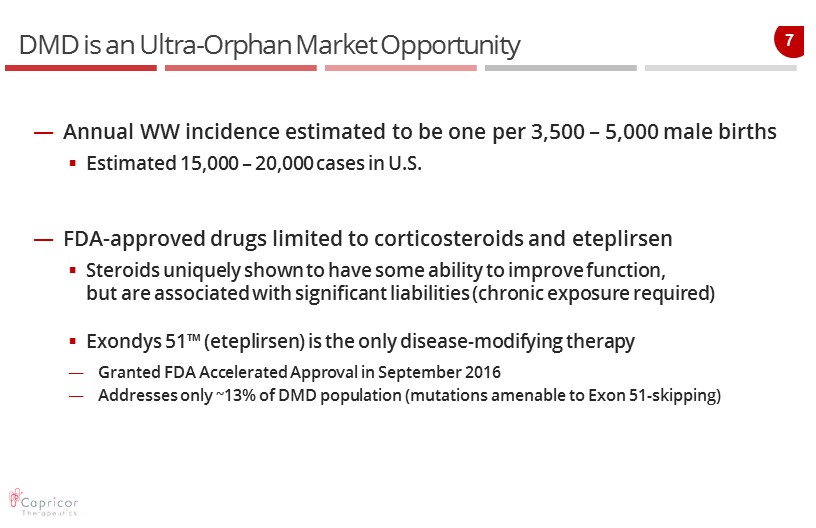
7 DMD is an Ultra - Orphan Market Opportunity — Annual WW incidence estimated to be one per 3,500 – 5,000 male births ▪ Estimated 15,000 – 20,000 cases in U.S. — FDA - approved drugs limited to corticosteroids and eteplirsen ▪ Steroids uniquely shown to have some ability to improve function, but are associated with significant liabilities (chronic exposure required) ▪ Exondys 51™ ( eteplirsen ) is the only disease - modifying therapy — Granted FDA Accelerated Approval in September 2016 — Addresses only ~ 13 % of DMD population (mutations amenable to Exon 51 - skipping)
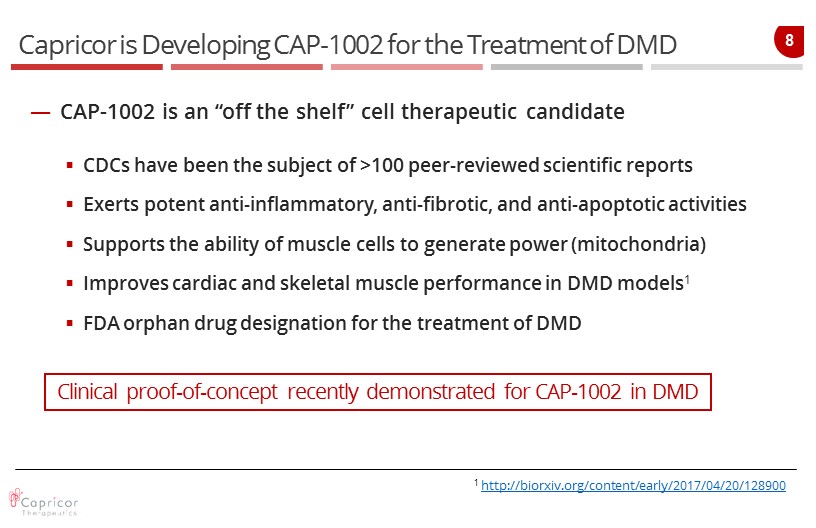
8 Capricor is Developing CAP - 1002 for the Treatment of DMD — CAP - 1002 is an “off the shelf” cell therapeutic candidate ▪ CDCs have been the subject of >100 peer - reviewed scientific reports ▪ E xerts potent anti - inflammatory, anti - fibrotic, and anti - apoptotic activities ▪ Supports the ability of muscle cells to generate power (mitochondria) ▪ I mproves cardiac and skeletal muscle performance in DMD models 1 ▪ FDA orphan drug designation for the treatment of DMD 1 http :// biorxiv.org/content/early/2017/04/20/128900 Clinical proof - of - concept recently demonstrated for CAP - 1002 in DMD

9 Phase I / II HOPE - Duchenne Clinical Trial – Ongoing CAP - 1002 (1 x 75M cells) Usual Care n=12 25 patients Ages 12 and older DMD heart disease n=13 6 12 — Trial population characterized by advanced disease: CAP - 1002 given by intracoronary infusion ▪ a ll are receiving steroids ▪ majority are non - ambulant — Most DMD clinical development to date has been conducted in less sick patients

10 Safety and Tolerability — CAP - 1002 was generally safe and well - tolerated — N o early study discontinuations due to adverse events — M ajority of treatment - emergent adverse events rated as mild or moderate — No clinical events associated with peri - procedural cardiac enzyme elevations

11 Exploratory Efficacy Endpoints Baseline Week 6 Month 3 Month 6 Month 12 Imaging Cardiac magnetic resonance ( cMRI ) ● ● ○ Functional Tests Performance of the Upper Limb (PUL) ● ● ● ● ○ 6 - Minute Walk Test ● ● ● ● ○ Spirometry ● ● ● ● ○ Quality of Life Pediatric QL Inventory ● ● ● ● ○ PODCI Adolescent Questionnaire ● ● ● ● ○ Biomarkers Osteopontin , ST2, IL - 10, Galectin - 3 ● ● ● ● ○

12 Reduced Cardiac Scar in CAP - 1002 Treated Patients Spontaneous scar reduction is not observed in DMD improvement

13 Improved Systolic Wall Thickening in CAP - 1002 Treated Patients Systolic thickening is believed to be a principal mechanism of cardiac output generation in DMD improvement (ns) (ns)
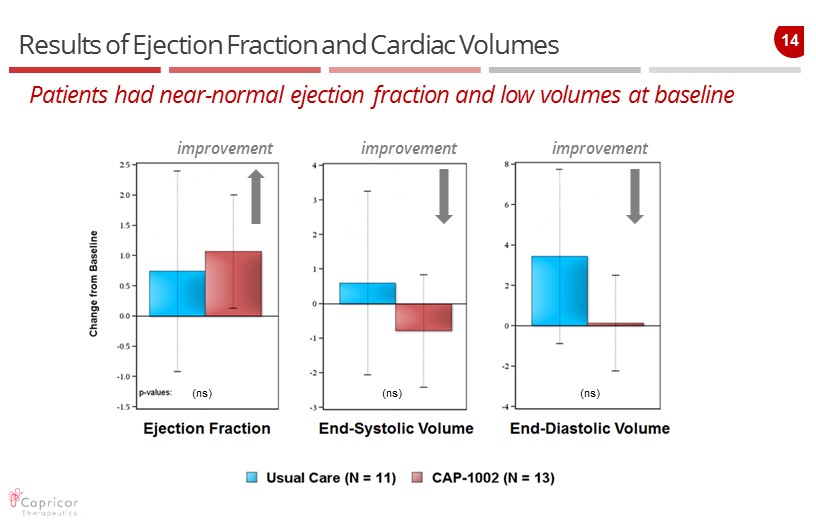
14 Results of Ejection Fraction and Cardiac Volumes Patients had near - normal ejection fraction and low volumes at baseline improvement improvement improvement (ns) (ns) (ns)

15 Performance of the Upper Limb (PUL ) Test
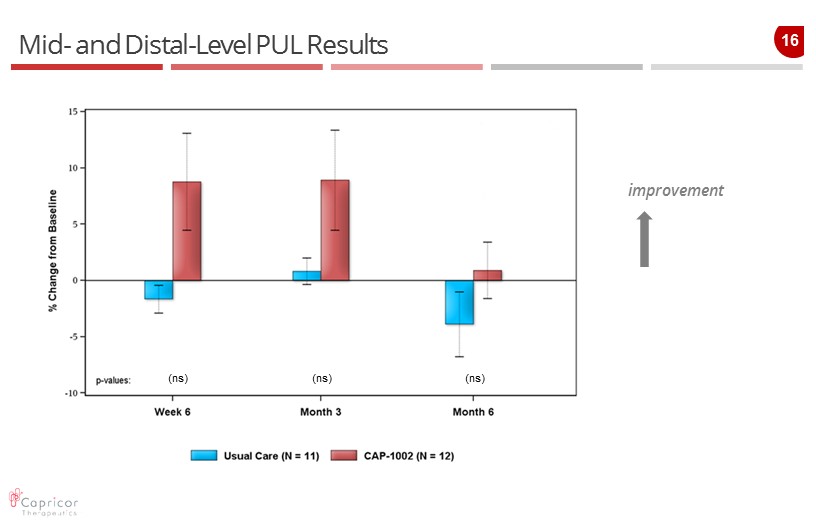
16 Mid - and Distal - Level PUL Results improvement (ns) (ns) (ns)

17 Responder Analysis on Mid - and Distal - Level PUL P otential functional improvement in skeletal muscle improvement Responder defined as ≥ 10% or max possible improvement (ns) (ns)
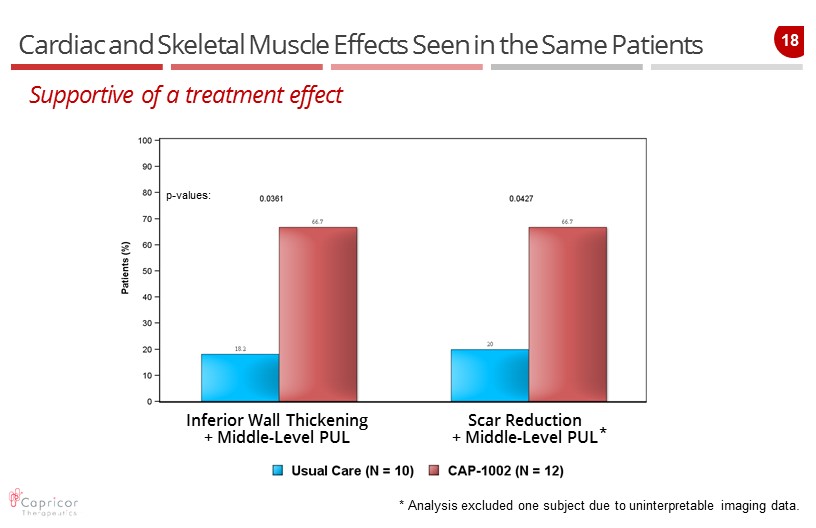
18 Cardiac and Skeletal Muscle Effects Seen in the Same Patients Inferior Wall Thickening + Middle - Level PUL Scar Reduction + Middle - Level PUL Supportive of a treatment effect p - values: * Analysis excluded one subject due to uninterpretable imaging data. *

19 Key Conclusions from Six - Month HOPE Data — Data support the potential benefit of CAP - 1002 to boys and young men with advanced Duchenne muscular dystrophy — CAP - 1002 was generally safe and well - tolerated — Limited duration of effect following a single dose indicates that sustained benefit will require repeat administration

20 Next Steps for Capricor’s Duchenne Muscular Dystrophy Program — FDA meeting set for late June to review HOPE data and discuss development toward potential registration — Plan to apply for Regenerative Medicine Advanced Therapy (RMAT) designation — Repeat dosing via intravenous delivery anticipated for next trial ▪ Chronic administration to potentially achieve long - term benefit ▪ Systemic delivery supported by studies in several models ▪ Plan to initiate in the second half of 2017, subject to regulatory approval
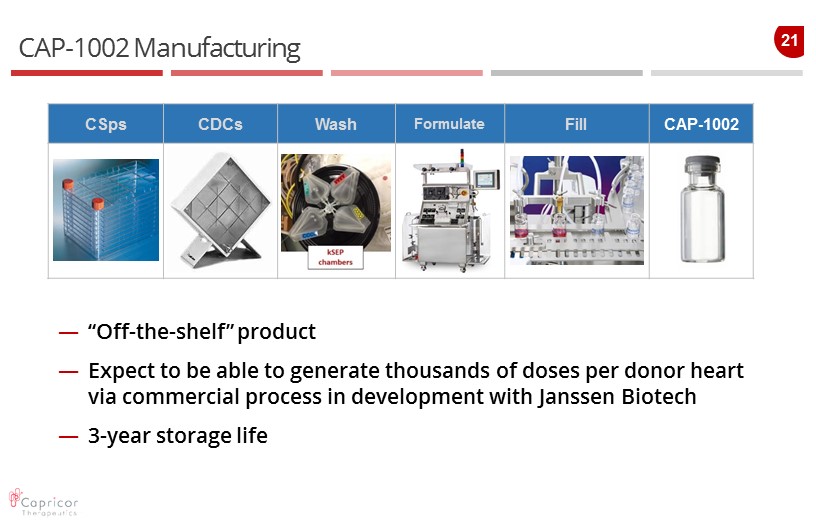
21 CAP - 1002 Manufacturing — “Off - the - shelf” product — Expect to be able to generate thousands of doses per donor heart via commercial process in development with Janssen Biotech — 3 - year storage life CSps CDCs Wash Formulate Fill CAP - 1002

22 Exosome Program “Next - Gen” Class of Biological Therapies

23 Exosomes – a Cell - Free Therapeutic Technology e ndothelial cells fibroblasts cardiomyocytes leukocytes CDC CDC exosomes

24 Financial Summary Capricor has received over $30 million in competitive grant and loan awards from: California Institute of Regenerative Medicine National Institutes of Health U.S. Department of Defense Cash and cash equivalents * $11.7 million (as of 3/31/17) Shares outstanding 22.6 million (as of May 12 , 2017 ) * $ 3.7 million raised in May 2017 PIPE offering.

25 Clinical Programs CAP - 1002 in Duchenne Muscular Dystrophy x April 2017: Reported top - line six - month results of HOPE trial Late June 2017: Type B meeting with FDA scheduled 2H 2017: Plan to initiate clinical trial of repeat - dose, intravenous CAP - 1002 * CAP - 1002 in Adult Heart Disease x May 2017: Announced interim analysis of ALLSTAR six - month data x May 2017 : Delivered ALLSTAR data dossier to Janssen x June 2017: Began transition of all patients in ALLSTAR to long - term follow - up Preclinical CAP - 2003 2018: Expect to submit IND for inflammatory disorder Recent and Upcoming Milestones * Subject to regulatory approval.
